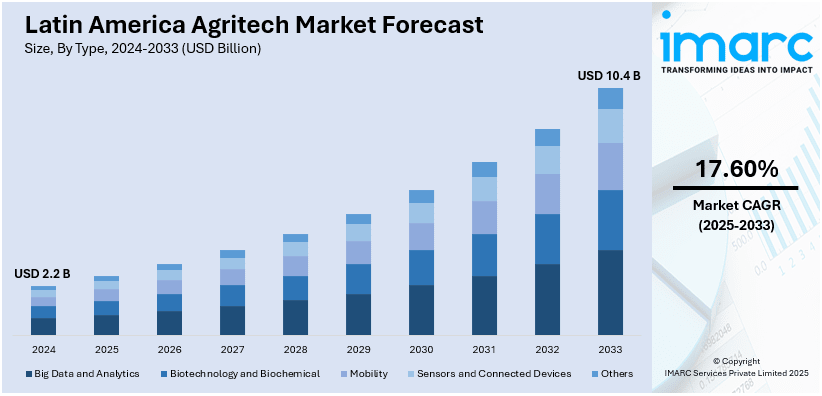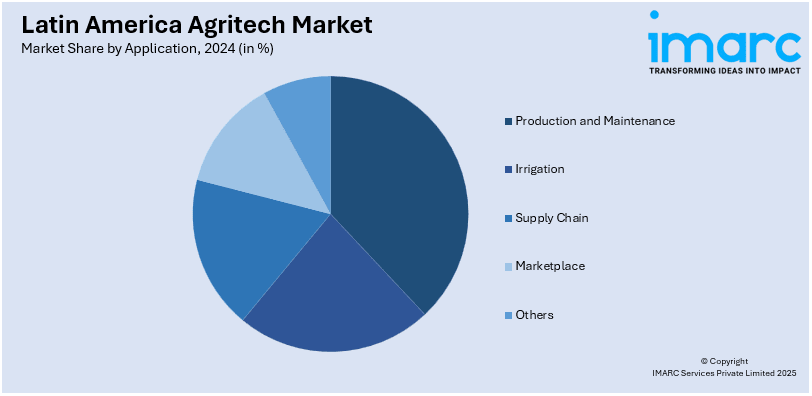
Latin America Agritech Market Size, Share, Trends and Forecast by Type, Sector, Application, and Country, 2025-2033
Latin America Agritech Market Overview:
The Latin America agritech market size reached USD 2.2 Billion in 2024. Looking forward, IMARC Group expects the market to reach USD 10.4 Billion by 2033, exhibiting a growth rate (CAGR) of 17.60% during 2025-2033. Digital farming, precision agriculture, and sustainable practices are positively impacting the Latin America agritech market share. Increased technology access, climate resilience initiatives, and growing investments are positioning the region as a significant player in global agritech advancements across the region.
|
Report Attribute
|
Key Statistics
|
|---|---|
|
Base Year
|
2024 |
|
Forecast Years
|
2025-2033
|
|
Historical Years
|
2019-2024
|
| Market Size in 2024 | USD 2.2 Billion |
| Market Forecast in 2033 | USD 10.4 Billion |
| Market Growth Rate 2025-2033 | 17.60% |
Latin America Agritech Market Trends:
Increase in Usage of IoT and Sensors
Farmers in Latin America are increasingly leveraging Internet of Things (IoT) devices and sensors to enhance agricultural productivity and sustainability, which is enhancing the Latin America agritech market outlook. These technologies enable real-time monitoring of critical factors such as soil moisture, temperature, humidity, and crop health. For instance, soil moisture sensors provide precise data that help optimize irrigation schedules, reducing water usage and preventing crop stress. Additionally, the launch of drones equipped with sensors can assess plant health as it aids in detection of pest infestations or nutritional inadequacies, which further enables prompt interventions. For instance, in March 2024, Wyld Networks announced its partnership with Elio Tecnologia to implement Wyld Connect for agriculture in Latin America. The collaboration aims to enhance agronomy models using satellite connectivity and drone imagery, targeting over 5,000 installations in Brazil within 36 months, with a potential order value of SEK 25 Million. Environmental sensors track weather conditions, enabling farmers to make informed decisions about planting and harvesting times. This data-driven approach not only increases yields and efficiency but also minimizes resource waste and environmental impact. By adopting IoT and sensor technologies, Latin American farmers can achieve more precise, sustainable, and profitable farming practices.

Sustainable Practices and Climate Resilience
Sustainable practices and climate resilience are becoming central to Latin America’s agritech advancements, which supports the Latin America agritech market growth. Agritech companies are actively promoting regenerative farming, which enhances soil health through techniques like cover cropping and no-till farming, thereby increasing carbon sequestration and biodiversity. Efficient irrigation systems, such as drip and precision irrigation, are being widely adopted to conserve water and optimize its use, crucial in areas prone to drought. In line with this, in September 2024, Hydrosat announced its partnership with EE Print Pack, Rex Irrigación Huasteca, and Grupo INDERS. These collaborations aim to enhance water efficiency and crop yields through the IrriWatch platform, which utilizes satellite data for precision irrigation. The initiative promotes sustainable agriculture, supporting farmers in Mexico and Guatemala with data-driven insights for improved productivity. Additionally, bio-based crop protection solutions, including natural pesticides and biological pest control, reduce reliance on chemical inputs, promoting healthier ecosystems and safer food products. These innovations are vital for the region, which faces significant climate challenges like extreme weather and shifting precipitation patterns. By embracing these sustainable practices, Latin American agriculture can achieve greater resilience, ensuring long-term productivity and environmental stewardship while mitigating the impacts of climate change.
Latin America Agritech Market Segmentation:
IMARC Group provides an analysis of the key trends in each segment of the market, along with forecasts at the regional level for 2025-2033. Our report has categorized the market based on type, sector, and application.
Type Insights:
- Big Data and Analytics
- Biotechnology and Biochemical
- Mobility
- Sensors and Connected Devices
- Others
The report has provided a detailed breakup and analysis of the market based on the type. This includes big data and analytics, biotechnology and biochemical, mobility, sensors and connected devices, and others.
Sector Insights:
- Precision Farming
- Agriculture
- Agrochemicals
- Smart Agriculture
- Biotechnology
- Indoor Farming
- Others
A detailed breakup and analysis of the market based on the sector have also been provided in the report. This includes precision farming, agriculture, agrochemicals, smart agriculture, biotechnology, indoor farming, and others.
Application Insights:

- Production and Maintenance
- Irrigation
- Supply Chain
- Marketplace
- Others
The report has provided a detailed breakup and analysis of the market based on the application. This includes production and maintenance, irrigation, supply chain, marketplace, and others.
Country Insights:
- Brazil
- Mexico
- Argentina
- Colombia
- Chile
- Peru
- Others
The report has also provided a comprehensive analysis of all the major regional markets, which include Brazil, Mexico, Argentina, Colombia, Chile, Peru, and others.
Competitive Landscape:
The market research report has also provided a comprehensive analysis of the competitive landscape. Competitive analysis such as market structure, key player positioning, top winning strategies, competitive dashboard, and company evaluation quadrant has been covered in the report. Also, detailed profiles of all major companies have been provided.
Latin America Agritech Market News:
- In June 2024, Syensqo announced its partnership with Agtech Innovation in Piracicaba, São Paulo, to enhance its agribusiness capabilities in South America. This collaboration aims to strengthen connections within the regional agribusiness ecosystem, fostering innovation among startups and major corporations.
- In February 2024, the Incofin Foundation, with support from IDB Lab, launched the Innovation Call ‘Advancing Digital Innovation for Smallholder Farmers in Latin America.’ The initiative seeks early-stage and mature agritech entities offering impactful solutions for smallholder farmers in Colombia, Bolivia, El Salvador, Paraguay, Honduras, and Peru.
- In August 2024, Psyche Aerospace, a Brazilian startup, announced its plans to launch Harpia P-71, the world's largest autonomous agricultural spraying drone, backed by a BRL15 Million investment. With plans to cover 1.2 Million hectares and produce 120 drones alongside 30 refueling stations, the company aims to enhance efficiency in farming, demonstrating innovation and sustainability in agribusiness.
Latin America Agritech Market Report Coverage:
| Report Features | Details |
|---|---|
| Base Year of the Analysis | 2024 |
| Historical Period | 2019-2024 |
| Forecast Period | 2025-2033 |
| Units | Billion USD |
| Scope of the Report |
Exploration of Historical Trends and Market Outlook, Industry Catalysts and Challenges, Segment-Wise Historical and Future Market Assessment:
|
| Types Covered | Big Data and Analytics, Biotechnology and Biochemical, Mobility, Sensors and Connected Devices, Others |
| Sectors Covered | Precision Farming, Agriculture, Agrochemicals, Smart Agriculture, Biotechnology , Indoor Farming , Others |
| Applications Covered | Production and Maintenance, Irrigation, Supply Chain, Marketplace, Others |
| Countries Covered | Brazil, Mexico, Argentina, Colombia, Chile, Peru, Others |
| Customization Scope | 10% Free Customization |
| Post-Sale Analyst Support | 10-12 Weeks |
| Delivery Format | PDF and Excel through Email (We can also provide the editable version of the report in PPT/Word format on special request) |
Key Questions Answered in This Report:
- How has the Latin America agritech market performed so far and how will it perform in the coming years?
- What is the breakup of the Latin America agritech market on the basis of type?
- What is the breakup of the Latin America agritech market on the basis of sector?
- What is the breakup of the Latin America agritech market on the basis of application?
- What is the breakup of the Latin America agritech market on the basis of country?
- What are the various stages in the value chain of the Latin America agritech market?
- What are the key driving factors and challenges in the Latin America agritech market?
- What is the structure of the Latin America agritech market and who are the key players?
- What is the degree of competition in the Latin America agritech market?
Key Benefits for Stakeholders:
- IMARC’s industry report offers a comprehensive quantitative analysis of various market segments, historical and current market trends, market forecasts, and dynamics of the Latin America agritech market from 2019-2033.
- The research report provides the latest information on the market drivers, challenges, and opportunities in the Latin America agritech market.
- Porter's five forces analysis assist stakeholders in assessing the impact of new entrants, competitive rivalry, supplier power, buyer power, and the threat of substitution. It helps stakeholders to analyze the level of competition within the Latin America agritech industry and its attractiveness.
- Competitive landscape allows stakeholders to understand their competitive environment and provides an insight into the current positions of key players in the market.
Need more help?
- Speak to our experienced analysts for insights on the current market scenarios.
- Include additional segments and countries to customize the report as per your requirement.
- Gain an unparalleled competitive advantage in your domain by understanding how to utilize the report and positively impacting your operations and revenue.
- For further assistance, please connect with our analysts.
 Request Customization
Request Customization
 Speak to an Analyst
Speak to an Analyst
 Request Brochure
Request Brochure
 Inquire Before Buying
Inquire Before Buying




.webp)




.webp)












